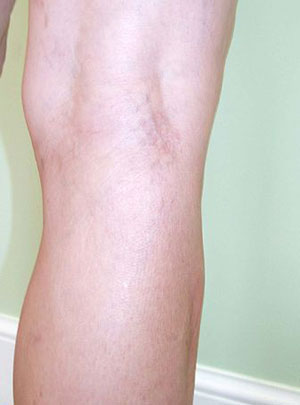
Find treatment for one of the most common forms of vein disease with spider vein removal in Boca Raton.
Sclerotherapy is a minimally invasive form of treatment for spider and varicose veins. The thin purple or red veins that you see in your legs may be just a cosmetic irritant to you, but those spider veins may also be causing some of the aching, burning, and cramping that you feel in your legs throughout the day.
Sclerotherapy treatments can provide you with younger-looking legs clear of unsightly veins while enhancing blood circulation. This form of vein therapy works by collapsing damaged veins with a specialized saline solution. The blood that pooled in the damaged vein then redirects itself through the surrounding veins.
During sclerotherapy, a specialized solution is injected directly into the problematic vein. Multiple veins can be treated with sclerotherapy during a single treatment session.
Sclerotherapy is often done for cosmetic purposes as the therapy will reduce or eliminate the appearance of spider and varicose veins. A single treatment session will last between 30 and 45 minutes.
Sclerotherapy can also reduce several of the symptoms associated with vein disease, including:
Prior to sclerotherapy, Dr. Schoenhaus will conduct a full medical examination and assess your medical history. Several lifestyle remedies may also be recommended, such as wearing compression stockings.
Sclerotherapy is considered mostly pain-free. This form of vein treatment is capable of removing up to 80 percent of varicose and spider veins. Veins will disappear gradually following treatment sessions. Smaller veins may be eliminated within three to six weeks, while larger veins often require three to four months for a full recovery.

Although these vein treatment procedures are perfectly safe, there are side effects that patients should be aware of so they may be addressed when they occur. Swelling or bruising in the area of treatment is possible, as well as temporary skin darkening and tiny red blood vessels. As your treated veins fade, so do these side effects.
Other side effects that should be immediately reported to a physician include allergic reactions to the treatment solution, inflammation in the area injected, and possible blood clots. Immediate attention to these side effects can prevent further complications. It is also suggested that pregnant women wait until after they deliver their child to have this type of treatment performed.


Your questions answered
Sclerotherapy is a minimally invasive form of treatment for spider and varicose veins. The thin purple or red veins that you see in your legs may be just a cosmetic irritant to you, but those spider veins may also be causing some of the aching, burning, and cramping that you feel in your legs throughout the day.
Sclerotherapy treatment can help you get rid of unsightly veins while enhancing blood circulation. This form of vein therapy works by collapsing damaged veins with a specialized saline solution. The blood that pooled in the damaged vein then redirects itself through the surrounding veins. During sclerotherapy, a specialized solution is injected directly into the problematic vein. Multiple veins can be treated with sclerotherapy during a single treatment session.
Vein diseases such as spider veins and varicose veins can be treated with sclerotherapy. Sclerotherapy can also reduce several of the symptoms associated with spider vein and varicose vein diseases, including: night cramps in the legs, burning, aching, and swelling.
Sclerotherapy is considered mostly pain-free. This form of vein treatment is capable of removing up to 80 percent of varicose and spider veins. Veins will disappear gradually following treatment sessions. Smaller veins may be eliminated within three to six weeks, while larger veins often require three to four months for a full recovery.
Although sclerotherapy treatment procedures are perfectly safe, there are side effects that patients should be aware of so they may be addressed when they occur, including:
Immediate attention to these side effects can prevent further complications. It is also suggested that pregnant women wait until after they deliver their child to have this type of treatment performed.